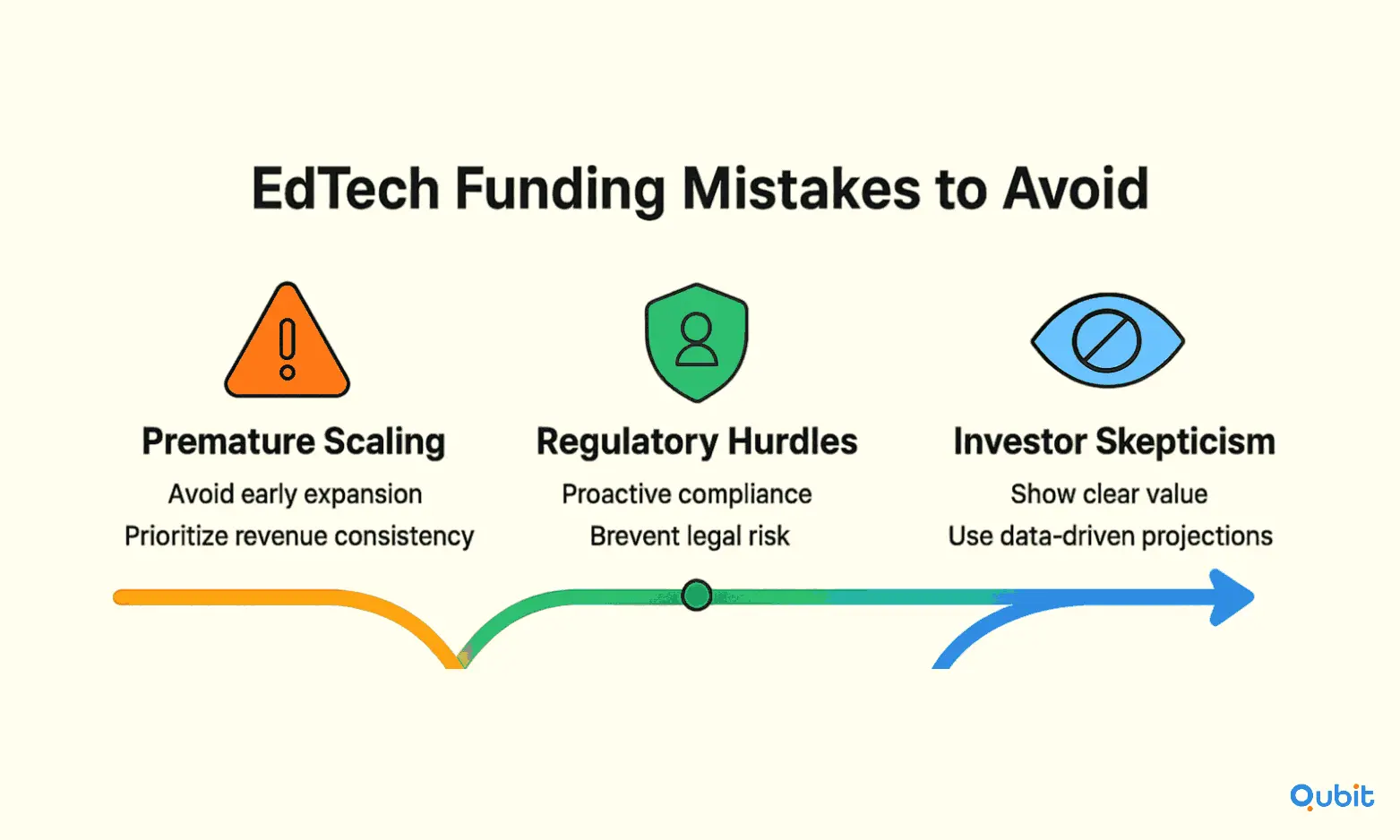With the global EdTech market projected to grow exponentially, entrepreneurs must explore diverse EdTech funding strategies to attract investors and scale their ventures. From venture capital to crowdfunding, the landscape offers numerous opportunities, but navigating these paths comes with challenges. Understanding distinct financial strategies, such as those discussed in funding models personalized learning edtech, can provide valuable insights into how tailored capital structures support groundbreaking educational platforms.
This blog delves into the opportunities and hurdles faced by EdTech startups in their fundraising journey, offering actionable insights to help founders secure the resources they need to thrive in this competitive industry.
Understanding Edtech Funding
The EdTech funding ecosystem is as diverse as the innovations it supports. From early-stage startups to established enterprises, funding opportunities come in various forms, each tailored to different growth stages and business needs. Understanding these options is crucial for securing the right financial backing.
Diverse Funding Sources
EdTech companies can tap into a wide array of funding sources. Venture capital (VC) firms are a popular choice for startups aiming to scale rapidly, offering not just capital but also strategic guidance. Angel investors, on the other hand, often provide smaller investments but are more accessible to early-stage ventures. For businesses looking for long-term growth, private equity firms offer substantial funding in exchange for equity stakes.
Government grants also play a significant role, especially for projects aligned with educational policies or technological advancements. These grants often come with specific criteria but can be a lifeline for startups with limited access to private funding. Additionally, community-driven crowdfunding platforms have emerged as an innovative way to raise funds while building a loyal user base.
For a deeper dive into these categories, the review of market trends highlights best edtech investors 2025, providing you with a comprehensive look at the range of funding avenues available to startups.
Global Market Growth and Investor Trends

The global EdTech market is on a remarkable growth trajectory. Projections indicate a compound annual growth rate (CAGR) of over 15% in the coming years, driven by increasing digital adoption in education. This growth has attracted a new wave of investors, including corporate venture arms and impact investors focused on social returns.
Emerging trends also show a shift towards funding models that prioritize sustainability and inclusivity. Investors are increasingly drawn to startups that address global challenges, such as accessibility to quality education in underserved regions.
How to Expand Your EdTech Funding Options
Combining traditional funding sources with alternative models can help diversify your capital streams and reduce reliance on a single approach. You can take the approaches mentioned below.
Traditional Funding Sources: A Reliable Foundation
Conventional methods like bank loans and venture capital (VC) investments remain essential for many EdTech startups. Bank loans provide predictable repayment terms, while VC funding offers access to expertise and networks that can accelerate growth. However, these routes often come with stringent requirements, such as high credit scores or equity stakes.
Exploring Alternative EdTech Funding Models
Diversifying your funding strategy with innovative approaches can unlock new opportunities:
- Crowdfunding Platforms: Engage your community to raise funds through platforms like Kickstarter or GoFundMe. This method not only generates capital but also builds early brand advocates.
- Revenue-Based Financing: Instead of giving up equity, consider funding models where repayment is tied to your revenue. This approach aligns investor returns with your business performance, offering flexibility during slower periods.
- Community Investment Funds: Tap into local or niche communities that share your vision. These funds often prioritize impact over profit, making them ideal for socially-driven EdTech initiatives.
Balancing Conventional and Alternative Strategies
A balanced approach ensures stability while fostering innovation. For example, pairing a bank loan with crowdfunding can provide immediate capital while validating market demand. Similarly, combining VC funding with revenue-based financing allows you to scale without diluting ownership excessively.
Investor communication strategies are dissected in storytelling for edtech pitch deck, where you discover a factual perspective on integrating narrative techniques to enhance pitch authenticity.
Your Step-by-Step Plan for Raising EdTech Capital
This section breaks down the process into actionable steps, starting with validating your concept through a minimum viable product (MVP), progressing through pre-seed and seed rounds, and exploring accelerator programs like Y Combinator to scale your growth.
1. Validate Your Idea with an MVP
Before approaching investors, it’s crucial to demonstrate the viability of your EdTech solution. Developing a minimum viable product (MVP) allows you to test your concept in the market, gather feedback, and refine your offering. Investors are more likely to support startups that have tangible proof of demand and a clear path to scalability.
An MVP doesn’t need to be perfect, it should focus on solving a specific problem for your target audience. Use the feedback from early adopters to iterate and improve your product. This validation phase not only strengthens your pitch but also builds confidence among potential investors.
2. Secure Pre-Seed Funding
Once your MVP demonstrates market potential, the next step is securing pre-seed funding. This round typically involves raising capital from friends, family, or angel investors who believe in your vision. Pre-seed funding is often used to refine your product, hire key team members, and prepare for larger funding rounds.
To attract pre-seed investors, craft a compelling pitch that highlights:
- The problem your EdTech solution addresses.
- Evidence of market demand, supported by MVP results.
- Your team’s expertise and ability to execute the vision.
3. Advance to the Seed Round
With a refined product and initial traction, you’re ready to approach institutional investors for seed funding. This round is critical for scaling your operations, expanding your team, and increasing your market reach. Seed investors often look for startups with a clear growth strategy and a scalable business model.
During this stage, focus on presenting:
- A detailed financial plan outlining how the funds will be used.
- Metrics showcasing user growth, engagement, or revenue potential.
- A roadmap for achieving milestones that align with investor expectations.
4. Explore Accelerator Programs
Accelerator programs can be transformative for EdTech startups seeking rapid growth. Joining a prestigious program like Y Combinator provides access to mentorship, networking opportunities, and increased visibility among top-tier investors.
Y Combinator, for example, is renowned for its ability to propel startups to success. Participating in such programs not only enhances your credibility but also equips you with the tools and connections needed to scale effectively. Many EdTech founders have leveraged Y Combinator’s resources to secure significant funding and establish a strong market presence.
5. Prepare for Long-Term Growth
As you progress through funding rounds, it’s essential to maintain a clear vision for your startup’s future. Investors want to see a commitment to innovation, adaptability, and sustained growth. Regularly revisit your business plan, refine your strategies, and ensure your team is aligned with your goals.
By following this step-by-step plan, you’ll position your EdTech startup as a compelling investment opportunity, paving the way for long-term success in a competitive market.
How to Build and Use Your EdTech Network for Success
Establishing a strong network in the EdTech industry can be the difference between growth and stagnation. Building connections with key stakeholders, investors, and partners not only opens doors to funding opportunities but also provides valuable insights into market trends and challenges.
1. Identify Influential Figures in EdTech
Start by pinpointing individuals and organizations that shape the EdTech ecosystem. These may include thought leaders, successful entrepreneurs, and EdTech investors. Platforms like LinkedIn and industry-specific events are excellent starting points for discovering these influential figures.
When reaching out, focus on creating authentic connections. Personalize your messages by referencing their work or contributions to the industry. This approach demonstrates genuine interest and lays the foundation for meaningful relationships.
2. Attend Industry Events and Conferences
EdTech conferences and meetups are prime opportunities to connect with investors, partners, and other stakeholders. Events such as EdTech Week or regional startup expos often attract key players in the industry. Prepare by researching attendees and creating a list of individuals you aim to meet.
During these events, prioritize quality over quantity. Engaging in thoughtful conversations and asking insightful questions can leave a lasting impression. Follow up promptly after the event to solidify the connection.
3. Build Relationships with EdTech Investors
EdTech investor outreach requires a strategic approach. Begin by researching investors who have funded similar ventures or express interest in your niche. Platforms like Crunchbase or AngelList can help identify potential investors.
When contacting investors, craft a compelling pitch that highlights your unique value proposition and aligns with their investment goals. Be transparent about your funding needs and demonstrate how their support will drive impact.
4. Collaborate with Partners and Stakeholders
Partnerships can amplify your reach and credibility. Collaborate with educational institutions, technology providers, or other startups to create mutually beneficial relationships. These partnerships can lead to shared resources, co-marketing opportunities, and enhanced visibility in the EdTech space.
To foster long-term collaborations, ensure clear communication and alignment of goals. Regular check-ins and updates can strengthen trust and maintain momentum.
Building an EdTech network is not just about connections; it’s about cultivating relationships that drive success. By identifying key figures, engaging at industry events, and fostering partnerships, you can create a network that supports your funding journey and beyond.
EdTech Funding Mistakes to Steer Clear Of
Among the most common edtech funding challenges are premature scaling, regulatory hurdles, and investor skepticism. Each of these pitfalls can significantly impact a startup’s ability to secure and sustain financial backing.

1. Premature Scaling
Scaling too early often leads to resource mismanagement. Startups may invest heavily in expanding operations or hiring before achieving product-market fit. This approach can drain funds and leave the company vulnerable to financial instability. Instead, founders should prioritize validating their business model and ensuring consistent revenue streams before scaling.
2. Regulatory Hurdles
EdTech startups frequently encounter complex regulatory requirements, especially when dealing with student data privacy or compliance standards like FERPA and GDPR. Failing to address these regulations upfront can result in legal complications and deter potential investors. A proactive approach to compliance not only mitigates risks but also builds investor confidence.
3. Investor Skepticism
Convincing investors to back an EdTech venture can be challenging due to the competitive nature of the industry. Skepticism often arises from concerns about scalability, market saturation, or the ability to generate sustainable revenue. To overcome this, startups must present clear, data-driven projections and demonstrate their unique value proposition.
Understanding these common pitfalls edtech startups face is essential for crafting a resilient funding strategy. By addressing these challenges head-on, founders can position their ventures for long-term success.
👉 Need expert guidance on funding strategies? Explore how Qubit Capital can help you navigate the complexities of EdTech funding.
Your Strategic Guide to Securing EdTech Funding
EdTech space requires more than just a great idea, it demands a well-structured approach that resonates with investors. By focusing on strategic EdTech funding best practices, you can position your business for long-term success while appealing to the psychology of potential backers. This section explores actionable strategies to craft a compelling EdTech business plan, align with investor priorities, and incorporate cutting-edge technology trends.
1. Build a Business Plan That Stands Out
A compelling EdTech business plan is the cornerstone of any successful funding pitch. Investors are drawn to clarity, scalability, and sustainability. To create a standout plan:
- Define your unique value proposition (UVP): Clearly articulate what sets your EdTech solution apart from competitors. Highlight how it addresses specific pain points in education.
- Showcase scalability: Investors want to see growth potential. Include projections that demonstrate how your product can expand into new markets or user bases.
- Detail your revenue model: Whether subscription-based, freemium, or one-time purchase, ensure your revenue streams are transparent and realistic.
2. Appeal to Investor Psychology
Understanding investor psychology in EdTech can significantly enhance your pitch. Investors often prioritize risk mitigation, market potential, and alignment with their values. To appeal to these factors:
- Highlight market demand: Use data to show the growing need for your solution. For example, emphasize trends like the rise of remote learning or AI-driven education tools.
- Address risks proactively: Be upfront about potential challenges and present strategies to overcome them. This builds trust and demonstrates foresight.
- Align with investor goals: Research your target investors to understand their priorities. Tailor your pitch to align with their interests, whether it’s social impact, innovation, or financial returns.
3. Stay Ahead with Technology Trends
Integrating cutting-edge technology trends into your EdTech solution can make your pitch more attractive. Investors are keen to back businesses that are future-ready. Consider these approaches:
- Adopt AI and machine learning: These technologies can personalize learning experiences, making your product more effective and appealing.
- Focus on user experience (UX): A seamless, intuitive interface can set your product apart. Investors recognize the importance of user satisfaction in driving adoption.
- Expand your online reach: Before approaching investors, enhance your visibility through strategies like content marketing.
By combining a robust business plan, an understanding of investor psychology, and a focus on technology trends, you can create a pitch that not only secures funding but also supports sustainable growth.
How AI and Personalized Learning Are Shaping EdTech Investments
Artificial intelligence and personalized learning are redefining the EdTech funding space, creating opportunities for startups to stand out in a crowded market. Investors are increasingly drawn to innovative solutions that optimize educational outcomes while addressing critical challenges like teacher workload and student engagement.
AI-Driven Solutions Capturing Investor Attention
AI in EdTech funding has become a focal point for investors seeking scalable and impactful technologies. Platforms that utilize AI to deliver tailored content to diverse learner profiles are particularly appealing. For instance, AI-driven efficiency prioritization enables solutions that reduce teacher workload while improving personalized learning outcomes. This dual benefit not only enhances classroom productivity but also aligns with the growing demand for individualized education models.
Startups integrating AI into their platforms can differentiate themselves by showcasing how their technology adapts to various learner needs. Explaining how your platform uses AI to deliver tailored content to diverse learner profiles can be a compelling narrative for investors.
Personalized Learning as a Competitive Edge
Personalized learning edtech funding is reshaping investment strategies, with market data illustrating its transformative impact. Investors are increasingly prioritizing platforms that offer adaptive learning experiences, catering to students' unique strengths and weaknesses. This approach not only improves educational outcomes but also positions startups as leaders in innovative edtech solutions.
Further reading on how personalized learning technology influences investors at scale can be found in the discussion on personalized learning edtech funding.
Differentiating Startups in a Competitive Market
To stand out, EdTech startups must align their pitch decks with investor priorities. Incorporating personalized learning statistics and showcasing the scalability of AI-driven solutions can significantly enhance their appeal. A thorough exploration of narrative structure reveals insights in edtech pitch deck tips, where you find an analytical perspective on aligning presentations with investor interests.
Conclusion
EdTech sector requires a blend of strategy, storytelling, and innovation. From understanding the diverse funding options available to adopting a systematic approach, each step plays a crucial role in building investor confidence. Crafting a compelling pitch deck that highlights clear outcomes and integrates a narrative-driven approach can help overcome skepticism and establish trust.
The actionable insights and examples shared throughout this article aim to equip you with the tools needed to approach EdTech funding effectively. Whether you're refining your pitch or exploring technological advancements, every detail matters in shaping your success.
If you're looking to connect with the right investors, we at Qubit Capital are here to help with our Investor Outreach service. Let’s start your funding journey today.
Key Takeaways
- A structured approach from MVP validation to scaling is essential for funding success.
- Diversifying funding sources with both traditional and alternative models mitigates dependency risks.
- A compelling pitch that clearly outlines your unique value proposition drives investor interest.
- Strong networking and accelerator participation significantly enhance credibility and exposure.
- Leveraging AI and personalized learning innovations can differentiate your startup in the competitive EdTech landscape.
Frequently asked Questions
What are the best funding strategies for EdTech startups?
Startups can secure funding by validating an MVP, leveraging diverse funding sources like VC, angel investors, government grants, and incorporating innovative strategies such as accelerator programs. Detailed, actionable steps and real-world examples can guide you through each stage.


 Back
Back



